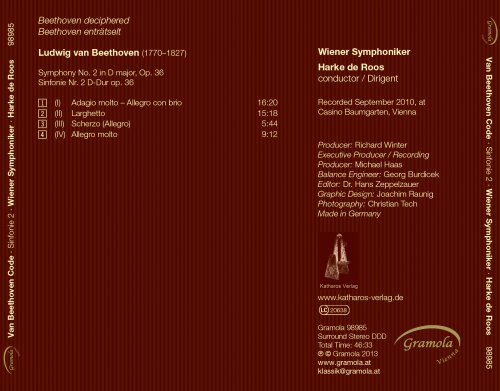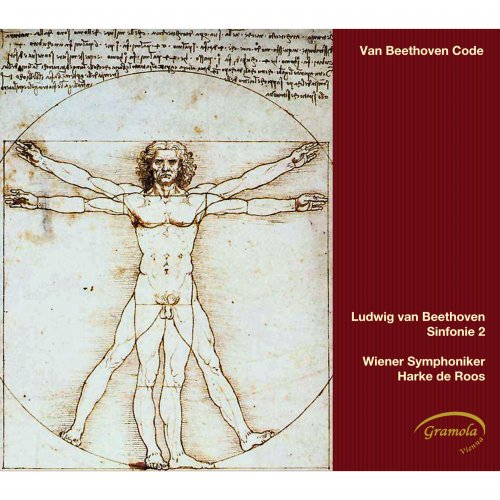
Wiener Symphoniker, Harke de Roos - Van Beethoven Code (2013)
BAND/ARTIST: Wiener Symphoniker, Harke de Roos
- Title: Van Beethoven Code
- Year Of Release: 2013
- Label: Gramola Records
- Genre: Classical
- Quality: flac lossless (tracks) +Booklet
- Total Time: 00:46:34
- Total Size: 191 mb
- WebSite: Album Preview
Tracklist
01. Symphony No. 2 in D Major, Op. 36: I. Adagio molto - Allegro molto
02. Symphony No. 2 in D Major, Op. 36: II. Larghetto
03. Symphony No. 2 in D Major, Op. 36: III. Scherzo
04. Symphony No. 2 in D Major, Op. 36: IV. Allegro molto

There have been speculations for long enough about tempo indications and metronome figures as regards Beethoven; after intensively studying sources, analysing scores and structural tempi, the Dutchman Harke de Roos casts a new light on the tempo relations. Accordingly, Beethoven's deliberate codification of the figures after 1817 due to his well-known aversion towards the metronome that was just being developed at the time should be taken with a pinch of salt. After all, the maestro wrote to its inventor: 'It is a silly plaything, you have to sense the tempos'. Hence, in accordance with de Roos, tempi are used in this performance of the 2nd Symphony in D major op. 34 in its 'original condition' by the Vienna Symphony Orchestra that extend from a third to half the time of usual performance practice today.
Harke de Roos, grew up in Zeeland in The Netherlands, studied piano at the 'Muzieklyceum' in Amsterdam and was awarded the soloist's diploma in 1968. He continued his studies at the same institution with a three-year course in concert conducting, while he embarked on the subject of opera as répétiteur at the Dutch Opera and with his own productions at Amsterdam University. From 1971 to 1982, Harke de Roos went through stages as a répétiteur and assistant conductor at the opera houses in Graz, Cologne and West Berlin. At the German Opera, he has accompanied singers such as Fischer-Dieskau and Pavarotti and assisted conductors like Karl Böhm, Charles Mackerras and Daniel Barenboim. From 1982 to 1995, de Roos worked as a conductor, initially as Kapellmeister in Detmold and recently as General Director of Music in Eisenach.
In his research on classical tempi in music, in 1986 he discovered the deliberateness of Beethoven's mysteriousness with profound consequences for performance practice and our knowledge about the period of Viennese Classicism. Since then, de Roos' work as an author has been one of his main occupations.
Not much needs to be said about the Vienna Symphony Orchestra. Founded in 1900, the leading orchestra in the city early became an indispensable component in Vienna's cultural life, also with premieres of works by Bruckner, Schoenberg or Ravel. Major principal conductors such as Kabasta, Swarovsky or Krips, von Karajan, Sawallisch and Prêtre have formed the orchestra and attached special value to its traditional Viennese sound. Since 2005, the Genoese Fabio Luisi has been the principal conductor of the Vienna Symphony Orchestra.
01. Symphony No. 2 in D Major, Op. 36: I. Adagio molto - Allegro molto
02. Symphony No. 2 in D Major, Op. 36: II. Larghetto
03. Symphony No. 2 in D Major, Op. 36: III. Scherzo
04. Symphony No. 2 in D Major, Op. 36: IV. Allegro molto

There have been speculations for long enough about tempo indications and metronome figures as regards Beethoven; after intensively studying sources, analysing scores and structural tempi, the Dutchman Harke de Roos casts a new light on the tempo relations. Accordingly, Beethoven's deliberate codification of the figures after 1817 due to his well-known aversion towards the metronome that was just being developed at the time should be taken with a pinch of salt. After all, the maestro wrote to its inventor: 'It is a silly plaything, you have to sense the tempos'. Hence, in accordance with de Roos, tempi are used in this performance of the 2nd Symphony in D major op. 34 in its 'original condition' by the Vienna Symphony Orchestra that extend from a third to half the time of usual performance practice today.
Harke de Roos, grew up in Zeeland in The Netherlands, studied piano at the 'Muzieklyceum' in Amsterdam and was awarded the soloist's diploma in 1968. He continued his studies at the same institution with a three-year course in concert conducting, while he embarked on the subject of opera as répétiteur at the Dutch Opera and with his own productions at Amsterdam University. From 1971 to 1982, Harke de Roos went through stages as a répétiteur and assistant conductor at the opera houses in Graz, Cologne and West Berlin. At the German Opera, he has accompanied singers such as Fischer-Dieskau and Pavarotti and assisted conductors like Karl Böhm, Charles Mackerras and Daniel Barenboim. From 1982 to 1995, de Roos worked as a conductor, initially as Kapellmeister in Detmold and recently as General Director of Music in Eisenach.
In his research on classical tempi in music, in 1986 he discovered the deliberateness of Beethoven's mysteriousness with profound consequences for performance practice and our knowledge about the period of Viennese Classicism. Since then, de Roos' work as an author has been one of his main occupations.
Not much needs to be said about the Vienna Symphony Orchestra. Founded in 1900, the leading orchestra in the city early became an indispensable component in Vienna's cultural life, also with premieres of works by Bruckner, Schoenberg or Ravel. Major principal conductors such as Kabasta, Swarovsky or Krips, von Karajan, Sawallisch and Prêtre have formed the orchestra and attached special value to its traditional Viennese sound. Since 2005, the Genoese Fabio Luisi has been the principal conductor of the Vienna Symphony Orchestra.
As a ISRA.CLOUD's PREMIUM member you will have the following benefits:
- Unlimited high speed downloads
- Download directly without waiting time
- Unlimited parallel downloads
- Support for download accelerators
- No advertising
- Resume broken downloads


